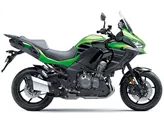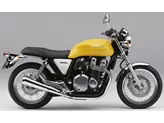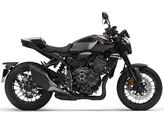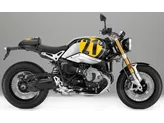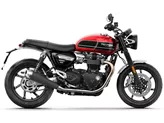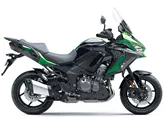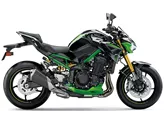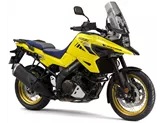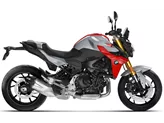Kawasaki Versys 1000 2016 vs. Kawasaki Z900 RS 2018

Kawasaki Versys 1000 2016

Kawasaki Z900 RS 2018
Visão geral - Kawasaki Versys 1000 2016 vs Kawasaki Z900 RS 2018
The Kawasaki Versys 1000 2016 and the Kawasaki Z900 RS 2018 are both motorcycles from Kawasaki, but they have some key differences in their specifications and features.
Starting with the engine and drivetrain, both motorcycles have an inline four-cylinder engine. The Versys 1000 has a larger displacement of 1043cc compared to the Z900 RS's 948cc. In terms of power, the Versys 1000 has a higher output with 120 HP compared to the Z900 RS's 111 HP. The torque is also higher in the Versys 1000 with 102 Nm compared to the Z900 RS's 98.6 Nm. Both motorcycles have a chain transmission.
In terms of suspension, both motorcycles have a telescopic fork front suspension with adjustment options for compression, preload, and rebound. The rear suspension of the Versys 1000 also has these adjustment options, while the Z900 RS only has adjustment options for preload and rebound.

Kawasaki Versys 1000 2016
The chassis of the Versys 1000 is made of aluminum, while the Z900 RS has a steel frame. This could result in a difference in weight and handling characteristics. Speaking of weight, the Z900 RS is lighter than the Versys 1000, weighing 215 kg compared to the Versys 1000's 250 kg (both weights include ABS).
In terms of dimensions, the Z900 RS has a shorter wheelbase of 1470 mm compared to the Versys 1000's 1520 mm. The seat height of the Z900 RS is also slightly lower at 835 mm compared to the Versys 1000's 840 mm. Both motorcycles have the same tire widths and diameters for the front and rear.
When it comes to fuel capacity, the Versys 1000 has a larger tank with a capacity of 21 liters compared to the Z900 RS's 17 liters.

Kawasaki Z900 RS 2018
Now let's move on to the strengths and weaknesses of each motorcycle. The Versys 1000 has a sporty appearance, a comfortable seating position, a powerful and well-maintained inline four-cylinder engine, an adjustable windshield, a stable chassis, a well-controlled braking system, a smart range of accessories, and a comparatively low price. Its weaknesses include the fact that the windshield is only adjustable when stationary and the gear indicator comes at an additional cost.
On the other hand, the Z900 RS has a powerful and smooth engine, a good-looking design, a comfortable seating position, easy handling, and balanced maneuverability. It is not nervous or heavy. Its weaknesses include the lack of a gear shift assist, being heavier than other retro bikes in its class, a too-soft seat for long rides, and the absence of wind protection.
In conclusion, the Kawasaki Versys 1000 2016 and the Kawasaki Z900 RS 2018 have their own strengths and weaknesses. The Versys 1000 offers a more sporty and versatile option with a larger engine and more adjustable suspension, while the Z900 RS provides a retro-styled bike with a powerful and smooth engine. Ultimately, the choice between the two will depend on the rider's preferences and intended use of the motorcycle.
Especificações técnicas Kawasaki Versys 1000 2016 em comparação com Kawasaki Z900 RS 2018
Prós e contras em comparação
Prós e contras em comparação
Kawasaki Versys 1000 2016

A Kawasaki Versys 1000 não é um modelo completamente novo - mesmo que se pareça com um do ponto de vista do design. O visual foi inteligentemente adaptado à atual linha agressiva da Kawasaki com dois faróis pontiagudos e muitas arestas na frente. Tecnicamente, por outro lado, foi cautelosamente atualizado - mas de forma bastante sensata. Dois cavalos de potência adicionais aumentam a potência para 120 cv, o que é excelente para conduzir graças às maravilhosas características de quatro cilindros em linha. O chassis corresponde às exigências desportivas de uma Kawasaki, mas a ergonomia e a posição confortável do assento permitem viagens longas - tal como uma grande enduro. Com acessórios úteis, tais como um conjunto de alforges, top case, punhos aquecidos e faróis adicionais, a Versys 1000 torna-se numa séria tourer de longa distância - o preço base comparativamente baixo torna estes acessórios bastante acessíveis.
Kawasaki Z900 RS 2018

Os seus quatro cilindros são suaves como a seda e fornecem potência suficiente para o fazer sorrir debaixo do capacete. É também muito fácil de deslocar, o que a torna uma excelente moto para o dia a dia e uma moto icónica e divertida para o fim de semana. O visual encontra o equilíbrio perfeito entre o design clássico e os detalhes modernos para formar um conjunto retro coerente que é também um tributo digno à história da Kawasaki. É uma excelente naked bike com um visual elegante.
Comparação de preços Preço médio de mercado Kawasaki Versys 1000 vs Kawasaki Z900 RS
There are a few key differences between a Kawasaki Versys 1000 2016 and a Kawasaki Z900 RS 2018. In terms of price, the actual average price of a Kawasaki Z900 RS 2018 is about 24% higher. A Kawasaki Versys 1000 2016 experiences a loss of 7.270 BRL in one year and 6.240 BRL in two years of ownership. This is offset by a loss of 6.040 BRL and 7.180 BRL for a Kawasaki Z900 RS 2018. Compared to Kawasaki Z900 RS 2018 there are less Kawasaki Versys 1000 2016 bikes available on the 1000PS.de Marketplace, specifically 7 compared to 28. It takes less time to sell a Kawasaki Versys 1000 with 88 days compared to 154 days for a Kawasaki Z900 RS. Since model year 2012 1000PS.de editors have written 19 reviews for the Kawasaki Versys 1000 and 26 reviews for the Kawasaki Z900 RS since model year 2018. The first review for the Kawasaki Versys 1000 was published on 07/11/2011 and now has more than 8.400 views. This compares to more than 63.700 views for the first review on Kawasaki Z900 RS published on 06/09/2017.



